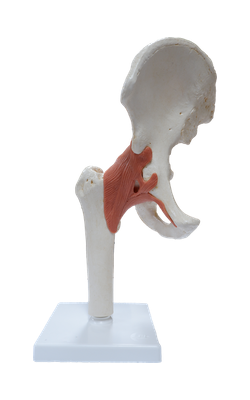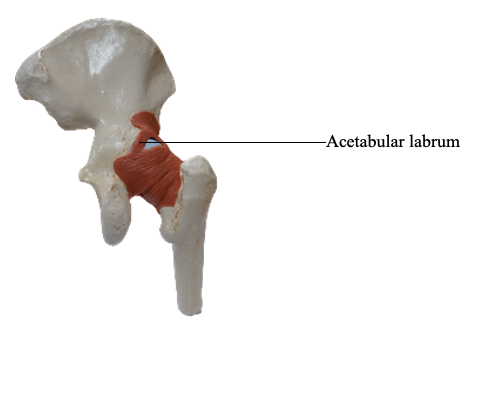Main Model

Acetabular labrum

Hip Joint
The hip joint forms the connection between the lower limb and the pelvic girdle. It is a strong and stable multiaxial ball and socket type of synovial joint. The head of the femur is the ball and the acetabulum is the socket. The hip joint is designed for stability over a wide range of movement. Next to the glenohumeral (shoulder) joint, it is the most movable of all joints. During standing, the entire weight of the upper body is transmitted through the hip bones to the heads and necks of the femora.
Articular Surfaces of Hip Joint
The round head of the femur articulates with the cup-like acetabulum of the hip bone. The head of the femur forms approximately two thirds of a sphere. Except for the depression or fovea for the ligament of the femoral head, all of the head is covered with articular cartilage, which is thickest over weight-bearing areas.
The acetabulum, a hemispherical hollow on the lateral aspect of the hip bone, is formed by the fusion of three bony parts. The heavy, prominent acetabular rim of the acetabulum consists of a semilunar articular part covered with articular cartilage, the lunate surface of the acetabulum. The acetabular rim and lunate surface form approximately three quarters of a circle; the missing inferior segment of the circle is the acetabular notch.
The lip-shaped acetabular labrum (Latin labrum, lip) is a fibrocartilaginous rim attached to the margin of the acetabulum, increasing the acetabular articular area by nearly 10%. The transverse acetabular ligament, a continuation of the acetabular labrum, bridges the acetabular notch. As a result of the height of the rim and labrum, more than half of the femoral head fits within the acetabulum. Thus during dissection, the femoral head must be cut from the acetabular rim to enable disarticulation of the joint. Centrally a deep non-articular part, called the acetabular fossa, is formed mainly by the ischium. This fossa is thin walled (often translucent) and continuous inferiorly with the acetabular notch.
The articular surfaces of the acetabulum and femoral head are most congruent when the hip is flexed 90°, abducted 5°, and rotated laterally 10° (the position in which the axis of the acetabulum and the axis of the femoral head and neck are aligned), which is the quadruped position!
In other words, in assuming the upright position, a relatively small degree of joint stability was sacrificed to maximize weight-bearing when erect. Even so, the hip joint is our most stable joint, owing also to its complete ball and socket construction (depth of socket), the strength of its joint capsule, and the attachments of muscles crossing the joint, many of which are located at some distance from the center of movement.